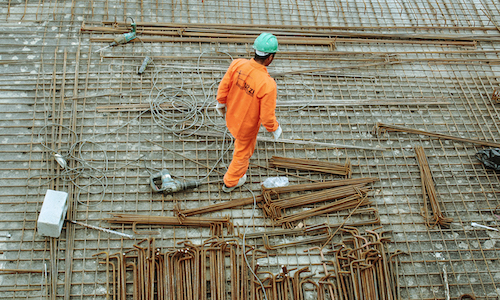Commercial buildings are built to withstand significant traffic from people and hold up to weather conditions. This is why contractors tend to choose similar materials based on how reliable they are, how easy they are to build with, and how consistent their results are over time. Although, as demand increases and workers become harder to find, new techniques and materials are being developed—especially for exterior finishing. Read on to learn more about common building materials, and what they are used for. We’ll also look at exterior materials and how exterior wall finishes for commercial buildings are adapting to meet growing demands with a shrinking workforce.

Materials Used in Commercial Buildings
First, let’s examine commercial buildings as a whole. Most utilize large amounts of just a handful of material types:
- Concrete is arguably the most common construction material. A mixture of coarse aggregate (i.e., gravel or crushed stone), cement, and water, it’s useful for commercial wall construction and building foundations, but also infrastructures, like bridges and even sewers.
- Stone is one of the oldest building materials around, and it’s still used to this day because of its ability to last. Each type of stone has varying degrees of grit or smoothness, which can be used for a wide range of purposes. It’s for this reason that stone is common in flooring and walls, as well as infrastructure applications, like retaining walls for erosion control, and as a base layer for pavement.
- Wood is arguably the oldest building material around. In addition to its durability and versatility, wood is also used for insulation purposes, and can easily be standardized by measurements (such as 2x4s). It’s sustainable to source and, like stone, has many types—each with different qualities.
- Brick is fire-resistant, durable, and known for its ability to withstand high amounts of compression. While useful and simple to install, brick is not usually used in the structure of commercial buildings. It is, however, commonly used as a veneer, giving a building the appearance of being made of brick without using traditional brickwork.
- Steel is a relatively new material, only being in common use for buildings since the late 19th century. Still, structural steel is single-handedly responsible for the ability to build skyward, reaching heights that masonry and carpentry simply could not. After the Home Insurance Building was finished—commonly known as the first skyscraper—structural steel became a go-to material.
These five materials make up just about every commercial building across the world and are used in many ways. As an example, let’s look at how these materials—and a few others—are used when building exterior walls.
What Is the Most Common Wall Material?
Here are some common commercial building exterior wall materials:
- Stone Veneer is possibly the most weather-resistant option. Stone is durable and can last for long periods of time. It is also usually the most expensive, though alternatives like manufactured stone veneer (MSV) keep the visual appearance of stone, while sacrificing some durability and reducing costs.
- Fiber Cement is a mixture of cement and cellulose fibers. Exterior walls made of this material are durable and can be molded to fit various looks. Unfortunately, it is also more expensive than many of the other materials.
- Brick has a lot of positive qualities as masonry or as a veneer, including its visual appeal and weather-resistance. It can, however, be costly to install and vulnerable to moisture, if proper precaution is not taken.
- Wood is not only sustainable but can have a lot of different looks through treatments such as staining. Its downsides are vulnerability to rot, fire, moisture, mold, as well as insects and other pests.
- Metal Cladding is a modern-looking choice that can give a refined look to commercial buildings, with various levels of weather-resistance depending on the material chosen.
- Vinyl is one of the cheapest exterior wall materials and one of the easiest to install, however, it doesn’t do well in extreme weather conditions.
- Stucco exterior walls are weather-resistant if installed properly; but stucco is vulnerable to moisture problems and rot if proper drainage, ventilation and embedment are not achieved.
With that in mind, let’s examine how those materials might be used with other, more focused materials for commercial wall construction.
3 Building Materials and Their Uses in Exterior Walls
No matter what material is used to build a wall, exterior finishes add needed protection—mostly from weather and general wear over time. The quality of an exterior finish greatly affects a building’s durability, and the quality of a finish depends on not just the materials used, but the construction process itself. A decreasing pool of skilled workers has made it harder to achieve a quality exterior finish, though some materials have been developed to help with this problem. Here are three key exterior wall materials used in commercial buildings:
- E-Flange Casing Beads™ - Meant to be used with stucco or plaster, these are designed to terminate stucco and plaster against doors, windows, and dissimilar materials. They provide significantly more embedment than traditional options.
- E-Screen - A product to provide drainage and ventilation, this can be used on a wide variety of exterior wall types, including stone veneer, brick, all types of siding, and stucco.
- Structa Wire - Used with both stone and stucco, this welded wire lath gives increased strength to exterior walls.
Some companies have also taken to forming systems that make installation easier for contractors. As an example, both Structa Wire and E-Flange are a part of ClarkDietrich’s Easy Embedment System™ (EES), which provides a much simpler installation process for stucco exteriors. Methods like these will help make building commercial structures easier, while also not sacrificing quality or structural integrity. You can dive deeper into materials through our learning resources, and you can learn more about methods like EES by visiting our YouTube channel.